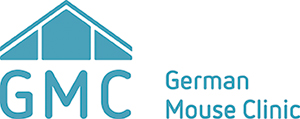Pipeline K - Allergy
The in vivo inflammation challenge platform offers the opportunity to clarify or enhance immune phenotypes from the screening pipeline where findings were unclear or subtle. Furthermore, the functionality of genes over the immune system cannot always be addressed by using an organism in a steady state (e.g., unchallenged). We assume that in vivo challenge screening will disclose new genes that are implicated in the mechanism of action or signaling networks affecting immune system functions. Thus, we established a straightforward animal in vivo test in the GMC to disclose possible implication over pathways associated to inflammatory processes.
The murine allergen airway inflammation model implicates both humoral and cell-mediated immune responses and consists in two phases: the sensitization of mice (by a potential allergen e.g. ovalbumin) and the challenge (e.g. aerosol exposure to allergen). The exposure to an aerosolized allergen triggers the infiltration of cells into the airways. This inflammation is the protecting response to a harmful stimulus, and it activates a wide range of immune parameters such as cytokines, immunoglobulins isotypes and the recruitment and proliferation of immune cells. Such biomarkers can be straightforwardly monitored in blood, lung or broncho-alveolar lavage fluid.
The allergy airway inflammation model is a terminal test. It is easy to implement and, compared to other alternatives such as infection models, requires no special safety condition or regulations. The model is very suitable for large-scale experiments enabling both high-throughput pipelines and robust statistical analysis for hit selection. The allergic airway inflammation test pipeline was already successfully applied for the effective selection of genes predisposing to an altered airway inflammatory response from a large compendium of mutant mouse lines.
Further important publications describing the methods:
1. Daubeuf F, Becker J, Aguilar-Pimentel JA, Ebel C, Hrabe de Angelis M, Herault Y, et al. A Fast, Easy, and Customizable Eight-Color Flow Cytometric Method for Analysis of the Cellular Content of Bronchoalveolar Lavage Fluid in the Mouse. Curr Protoc Mouse Biol. 2017;7(2):88-99. doi: 10.1002/cpmo.26. PubMed PMID: 28628216.
2. Horsch M, Aguilar-Pimentel JA, Bonisch C, Come C, Kolster-Fog C, Jensen KT, et al. Cox4i2, Ifit2, and Prdm11 Mutant Mice: Effective Selection of Genes Predisposing to an Altered Airway Inflammatory Response from a Large Compendium of Mutant Mouse Lines. PloS one. 2015;10(8):e0134503. doi: 10.1371/journal.pone.0134503. PubMed PMID: 26263558.
3. Fuchs H, Gailus-Durner V, Adler T, Aguilar-Pimentel JA, Becker L, Calzada-Wack J, et al. Mouse phenotyping. Methods. 2011;53(2):120-35. Epub 2010/08/17. doi: 10.1016/j.ymeth.2010.08.006. PubMed PMID: 20708688.

